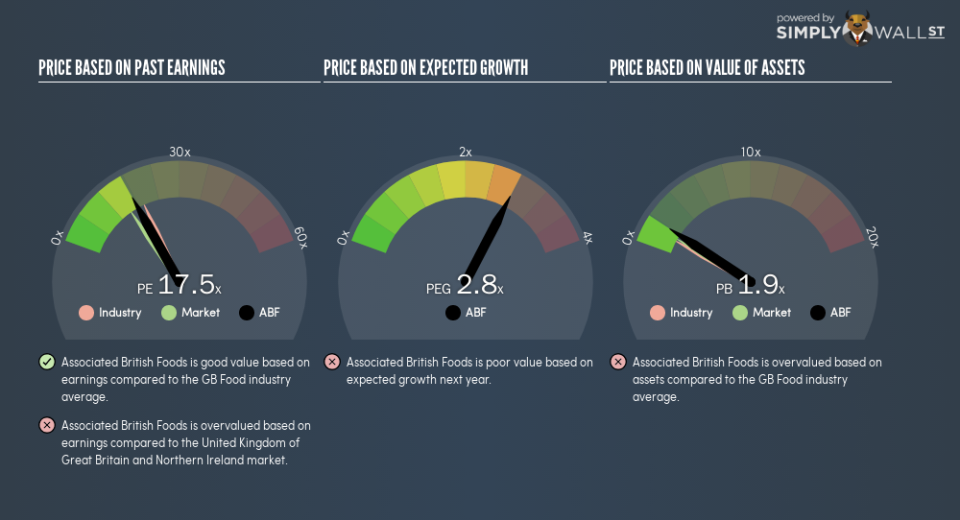Do You Know What Associated British Foods plc’s (LON:ABF) P/E Ratio Means?

The goal of this article is to teach you how to use price to earnings ratios (P/E ratios). We’ll look at Associated British Foods plc’s (LON:ABF) P/E ratio and reflect on what it tells us about the company’s share price. Associated British Foods has a price to earnings ratio of 17.5, based on the last twelve months. In other words, at today’s prices, investors are paying £17.5 for every £1 in prior year profit.
View our latest analysis for Associated British Foods
How Do You Calculate Associated British Foods’s P/E Ratio?
The formula for price to earnings is:
Price to Earnings Ratio = Share Price ÷ Earnings per Share (EPS)
Or for Associated British Foods:
P/E of 17.5 = £22.31 ÷ £1.27 (Based on the year to September 2018.)
Is A High P/E Ratio Good?
A higher P/E ratio implies that investors pay a higher price for the earning power of the business. All else being equal, it’s better to pay a low price — but as Warren Buffett said, ‘It’s far better to buy a wonderful company at a fair price than a fair company at a wonderful price.’
How Growth Rates Impact P/E Ratios
Earnings growth rates have a big influence on P/E ratios. That’s because companies that grow earnings per share quickly will rapidly increase the ‘E’ in the equation. That means unless the share price increases, the P/E will reduce in a few years. So while a stock may look expensive based on past earnings, it could be cheap based on future earnings.
Associated British Foods shrunk earnings per share by 16% over the last year. But it has grown its earnings per share by 14% per year over the last five years.
How Does Associated British Foods’s P/E Ratio Compare To Its Peers?
We can get an indication of market expectations by looking at the P/E ratio. If you look at the image below, you can see Associated British Foods has a lower P/E than the average (19.8) in the food industry classification.
Its relatively low P/E ratio indicates that Associated British Foods shareholders think it will struggle to do as well as other companies in its industry classification. While current expectations are low, the stock could be undervalued if the situation is better than the market assumes. It is arguably worth checking if insiders are buying shares, because that might imply they believe the stock is undervalued.
A Limitation: P/E Ratios Ignore Debt and Cash In The Bank
The ‘Price’ in P/E reflects the market capitalization of the company. In other words, it does not consider any debt or cash that the company may have on the balance sheet. In theory, a company can lower its future P/E ratio by using cash or debt to invest in growth.
Such spending might be good or bad, overall, but the key point here is that you need to look at debt to understand the P/E ratio in context.
How Does Associated British Foods’s Debt Impact Its P/E Ratio?
Since Associated British Foods holds net cash of UK£614m, it can spend on growth, justifying a higher P/E ratio than otherwise.
The Verdict On Associated British Foods’s P/E Ratio
Associated British Foods trades on a P/E ratio of 17.5, which is above the GB market average of 15.2. The recent drop in earnings per share would make some investors cautious, but the healthy balance sheet means the company retains potential for future growth. If fails to eventuate, the current high P/E could prove to be temporary, as the share price falls.
When the market is wrong about a stock, it gives savvy investors an opportunity. People often underestimate remarkable growth — so investors can make money when fast growth is not fully appreciated. So this free visualization of the analyst consensus on future earnings could help you make the right decision about whether to buy, sell, or hold.
But note: Associated British Foods may not be the best stock to buy. So take a peek at this free list of interesting companies with strong recent earnings growth (and a P/E ratio below 20).
To help readers see past the short term volatility of the financial market, we aim to bring you a long-term focused research analysis purely driven by fundamental data. Note that our analysis does not factor in the latest price-sensitive company announcements.
The author is an independent contributor and at the time of publication had no position in the stocks mentioned. For errors that warrant correction please contact the editor at editorial-team@simplywallst.com.

 Yahoo Finance
Yahoo Finance 
